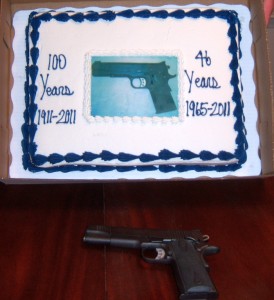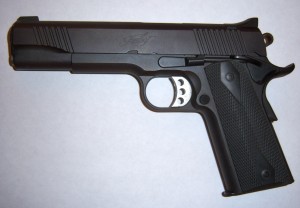I’ve known Karl Rehn for over two decades. Founder and owner of KR Training, a certified NRA instructor, Master Class tactical handgun shooter, and teacher of SWAT teams and other first responders from around the country, I wanted to get his analysis of the Ft. Hood shooting, so I emailed him some questions (in italics below).
1. When faced with a spree shooter, what is the first thing an unarmed person should do to maximize their survival chances?
The term typically used by law enforcement is “active shooter”.
What to do? Take action. There is no one universal action that is guaranteed to work in all situations, because all of these variables are in play:
– weapon(s) in use by the shooter
– shooter’s ability
– your distance from the shooter
– what others are doing around you
– features of the building or environment you are in
If the shooter isn’t in the room you are in now and isn’t aware of you, escape, moving away from the sound of the gunfire. If you are in a room with no avenue of escape except toward the gunfire, lock the door and block it to deny the shooter access to that room.
Find something to get behind that might stop a bullet, and find something (or multiple things) that you could use to defend yourself should the shooter gain access to the room. Anything that can be thrown or swung like a club is better than empty hands.
If you are in the same area as the shooter, try to gain the element of surprise and counterattack as aggressively as you can with whatever weapons you can improvise. Public authorities cannot advise citizens to fight back out of fear of liability if citizens are injured or killed fighting back.
The lessons of previous active shooters incidents are that those that do nothing do not survive. Those that take action have better odds. Go back and read the accounts of the survivors of Virginia Tech. Those that fled quickly, locked and blocked doors and took other defensive actions lived and/or saved others.
2. Likewise, what is the first thing an armed citizen should do?
The advice is the same. The only difference is that the armed citizen will have some weapons available.
Armed citizens are not police officers and have no specific duty to use deadly force to save others or even in their own self defense. Any person moving within an area where there is an active shooter could be mistaken for the shooter by responding officers and shot or killed. There is great risk in an armed citizen going into “hero mode”, both from the shooter and from responding officers. Choosing to do anything beyond protecting yourself is a very personal decision. Some students have told me that they simply could not retreat in a situation where they could save others, regardless of the risk.
Unarmed friends, associates, and family members of those who regularly carry need to understand that in this type of situation, they need to refrain from doing or saying anything that would cause the armed person (off duty officer or armed citizen) to lose the critical element of surprise in a counterattack.
3. What particular actions did Officer Kimberly Munley undertake that helped limit Maj. Nidal Malik Hasan’s death toll?
I don’t have enough specifics to comment. I know that she attended multiple law enforcement courses offered by TEEX (http://www.teex.org), including the ALERRT program, which specifically trains officers how to respond to an active shooter.
4. Have you undertaken any specific active shooter scenarios for KR Training classes?
We have a block of scenarios set in a convenience store in one of our “force on force” classes. In those scenarios, students are placed in a variety of roles, including store employee, unarmed citizen and armed citizen. During the scenarios, each student has to make decisions based on the behavior of the other roleplayers, and the timing and position of people within the store. What they learn from this is how to read a situation and determine the best course of action. Some scenarios end with deadly force and some do not.
5. Obviously, information about Hasan’s shooting spree is fairly sparse right now. Of the limited information available, does anything strike you of being notable about this incident?
If it had occurred outside the base, where citizens have the right to carry, there probably would have been one or more armed citizens present that might have taken action to stop the attack earlier in the incident. An armed citizen in Tyler took action during an active shooter incident a few years ago. He was killed by the shooter, but police and city leaders credited his action with saving many lives, including those of police officers.
6. What do you think about the quality of the news coverage of the issue?
During the first evening of coverage, I watched CNN because I was staying in a hotel that did not get other news channels. They repeated the phrase “he had a semiautomatic handgun, and that allowed him to get off lots of shots quickly” over and over again.
The truth is that a revolver can be fired just as quickly as a semiautomatic handgun, and both fire one shot for each pull of the trigger. This is yet another example of reporters showing their ignorance of gun technology and/or their personal biases toward gun control.
The real story was that he chose a place where he knew that people would be unarmed. Active shooter incidents never happen at shooting ranges and gun shows. Theoretically if guns were the primary ’cause’ of violence, those places would be the most dangerous.
The history of active shooter incidents is full of cases where the shooter chose a ‘gun free zone’ as the killing ground — and the mainstream media and most Americans continue to blind themselves to this glaring truth, because recognizing it would require them to accept that concealed carry is a deterrent to crime, and that the best approach to personal defense includes carrying a concealed handgun.
7. What base and/or army policies do you think helped contributed to the tragedy?
It’s a real tragedy that people that we trust to carry arms in a combat zone were not trusted by their own leaders with the same rights that citizens of Texas are trusted by their government outside the base.
8. Any final thoughts on how to prevent such incidents in the future, or the best ways for bystanders or police to respond to minimize the death toll for future incidents?
The most important step each adult should take is to understand that when seconds count, professional help is minutes away. Every adult should learn enough self-defense, first aid and firefighting skills to be able to take action in that critical period between the start of the incident and the arrival of professional help. That means getting training in armed and unarmed self defense, CPR, basic first aid, how to use a fire extinguisher — skills that might keep you and those you care about alive until better equipped, better trained help can arrive. A teacher at Columbine died because he bled to death waiting for the SWAT team to clear the building to let medics in. The basic medical training that soldiers receive saved some lives in this incident, as they applied tourniquets and took other measures to treat those that were shot. That aspect of this incident should not be overlooked or forgotten. Even those that are morally opposed to violence or believe themselves physically or psychologically incapable of fighting can and should be willing to render aid. There are emergency trauma kits and video tutorials available from law enforcement supply companies and training schools like Tactical Response (http://www.tacticalresponse.com). One of these should be in every adult’s car, along with other emergency items like a flashlight, fire extinguisher, and pepper spray. Better to have it and not need it than to need it and not have it.




